
Fragaria is a genus of flowering plants in the rose family, Rosaceae, commonly known as strawberries for their edible fruits. There are more than 20 described species and many hybrids and cultivars. The most common strawberries grown commercially are cultivars of the garden strawberry, a hybrid known as Fragaria × ananassa. Strawberries have a taste that varies by cultivar, and ranges from quite sweet to rather tart. Strawberries are an important commercial fruit crop, widely grown in all temperate regions of the world.

Psychotria viridis, also known as chacruna, chacrona, or chaqruy in the Quechua languages, is a perennial, shrubby flowering plant in the coffee family Rubiaceae. It is a close relative of Psychotria carthagenensis of Ecuador. It is commonly used as an ingredient of ayahuasca, a decoction with a long history of its entheogenic use and its status as a "plant teacher" among the Indigenous peoples of the Amazon rainforest.

Pellaea is a genus of ferns in the Cheilanthoideae subfamily of the Pteridaceae. The genus name is derived from the Greek word πελλος (pellos), meaning "dark," and refers to the brown stems. Many members of the genus are commonly known as cliffbrakes. They primarily grow in rocky habitats, including moist rocky canyons, slopes, and bluffs.

Pellaea andromedifolia, with the common names coffee cliffbrake and coffee fern, is a species of cliff brake fern in the Cheilanthoideae subfamily of the Pteridaceae. It is native to California in the United States and Baja California in Mexico.
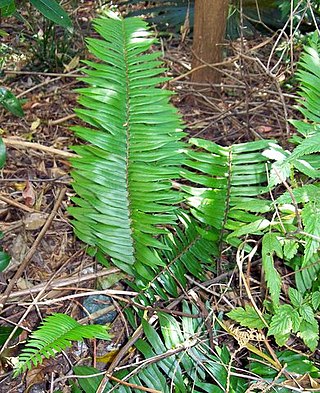
Pellaea falcata, the sickle fern, is a widespread and common plant, growing in eastern Australia. It is often seen in on the coast and ranges in eucalyptus forest and rainforest. It grows in Tasmania, Victoria, New South Wales, Queensland, and Lord Howe Island.

Pellaea atropurpurea, commonly known as purple-stem cliffbrake or just purple cliffbrake, is a fern native to North and Central America. Brake is an old word for fern, related to the word bracken. Like many other members of the Pteridaceae, it is a rock plant, needing a calcareous substrate.

Pellaea brachyptera is a species of fern known by the common name Sierra cliffbrake. It is native to the coastal and inland mountains of northern California and Oregon, and a disjunct population was discovered in Chelan County, Washington, in 1986.
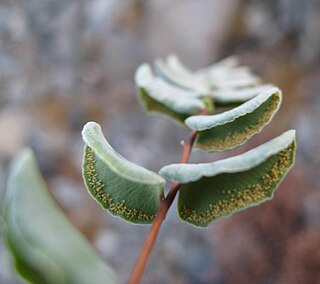
Pellaea bridgesii is a species of fern known by the common name Bridges' cliffbrake. It is native to an area of the western United States from northern California to Idaho, where it grows in rocky granitic cliffs and slopes.

Pellaea truncata is a species of fern known by the common name spiny cliffbrake. It is native to the southwestern United States and northern Mexico, where it grows in rocky areas, such as cliffs and slopes.

Pellaea calidirupium, the hot rock fern, is a fern of eastern Australia and New Zealand restricted to rocky areas in relatively arid environments. In Tasmania, where it is considered rare, it is only found on the East Coast, the Midlands, and lower slopes of the Central Plateau on dry rock faces. It is also found in Victoria and Queensland. The species was originally described from New Zealand.

Pellaea glabella is a fern with the common name smooth cliffbrake. It was once regarded as a reduced form or variety of Pellaea atropurpurea. P. glabella is known to exist in two cryptic species, one diploid and one tetraploid. The diploid reproduces sexually, while the tetraploid is normally apogamous. It is now known that the tetraploid form of the species is one of the parents of the original hybrid P. × atropurpurea that became the apogamous species.

Pellaea rotundifolia, the button fern, is a species of fern endemic to New Zealand, where it grows in scrub and forests. It is also a popular garden plant and house plant, tolerating low temperatures but not freezing.
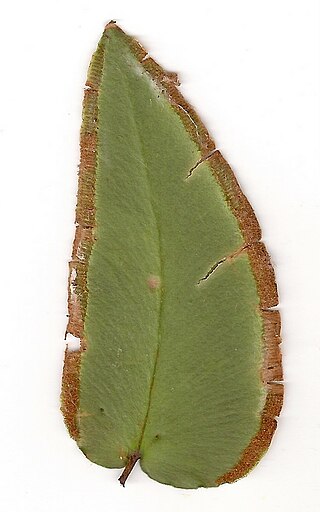
Pellaea paradoxa is a small hardy fern found north of Sydney in eastern Australia and Lord Howe Island. Often growing in or near rainforests in rocky crevices. But it may occasionally be seen in drier areas. Fronds are usually curved, 4 to 9 cm long, and 1 to 4 cm wide. Leathery to touch and a dull green. Juvenile fronds may be heart shaped. The stalks are around 1 to 5 mm long. Sori appear in a band, usually 2 to 3 mm wide, at the edge of the underside of the fronds.
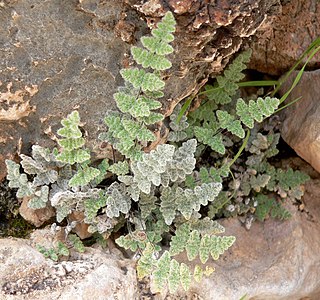
Cheilanthoideae is one of the five subfamilies of the fern family Pteridaceae. The subfamily is thought to be monophyletic, but some of the genera into which it has been divided are not, and the taxonomic status of many of its genera and species remains uncertain, with radically different approaches in use as of December 2019.

Eulalia viridis is a species of bright-green polychaete worm in the family Phyllodocidae. It can range from 5 to 15 cm in length and is usually found in shallow north Atlantic water under rocks or in mussel beds.
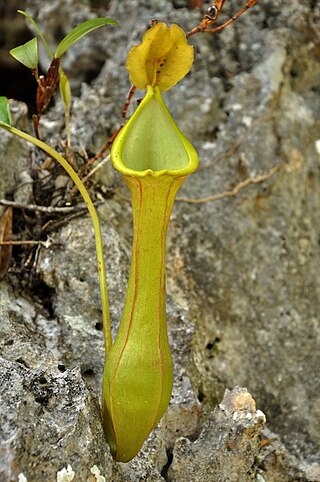
Nepenthes viridis is a tropical pitcher plant endemic to the Philippines. It is known only from coastal areas at low altitude and has been recorded from Dinagat, Samar, and a number of surrounding islets. It is closely allied to the N. alata group of species.
Argyrochosma connectens is a small cheilanthoid fern endemic to Sichuan, China. It is the only member of its genus known from Asia. Relatively rare, it is found growing in the crevices of limestone rocks in hot, dry valleys. The species was long classified in the genus Pellaea, but after a phylogenetic study in 2015 was transferred to Argyrochosma.
Pellaea may refer to one of two different genera:















